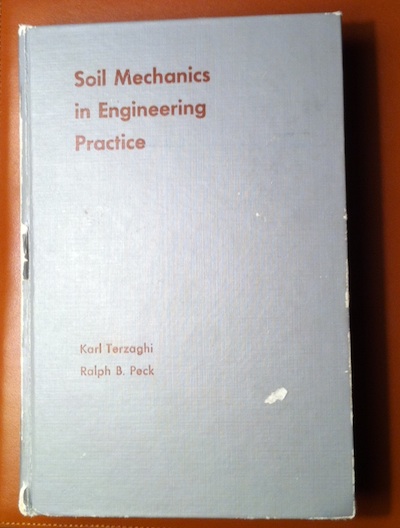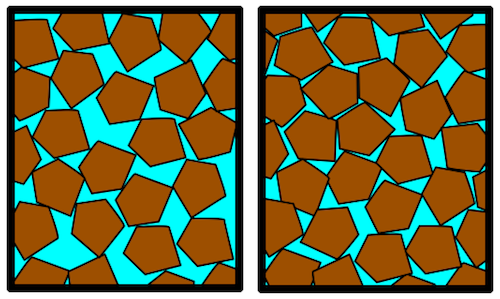Soil liquefaction
March 11, 2011 at 8:33 AM by Dr. Drang
Several days ago, Cory Doctorow posted this video on Boing Boing. It’s a cute demonstration of soil liquefaction in a wheelbarrow.
Not so cute is what soil liquefaction can do. The maker of the video got the soil from his garden in Christchurch, New Zealand, where last month’s earthquake did a lot of damage through liquefaction.
Doctorow doesn’t link to any decent discussion of soil liquefaction, although they’re not hard to find. And not surprisingly, most of the post’s commenters1 decided to describe their own ideas about liquefaction instead of looking for real information.
Because my readers are a lot smarter than the average Boing Boing reader, you won’t be surprised to hear that geotechnical engineers have spent a lot of time studying liquefaction, and its causes are pretty well known. I am not a geotechnical engineer, but I did take three soil mechanics/foundation design classes while in college (it’s considered valuable for structural engineers to have some idea of how the foundations under their structures work), so I’m not completely uninformed on the subject.
What follows is taken mostly from my treasured copy of Soil Mechanics in Engineering Practice by Karl Terzaghi and Ralph Peck, two giants of soil mechanics (it’s only a bit of a stretch to say Terzaghi invented soil mechanics). The book I’ve linked to is the third edition, which has been updated by Gholamreza Mesri (and which I also have), but the copy I’m most familiar with is a beat-up second edition from 1967.

The structure of granular soil
Granular soils are made up of particles that don’t fit together perfectly. The density or looseness of the soil is characterized by its void ratio which is defined as
where is the total volume, is the volume of the solid particles within that total volume, and is the volume of the void space between the particles. Loose sands can have a void ratio of as much as 80%, which means the soil has nearly as much void as solid matter.
For every granular soil there’s a critical void ratio, , that determines its behavior when it’s disturbed. The particles in a soil with tend to become more tightly packed when the soil is disturbed. Conversely, the particles in a soil with tend to spread apart when disturbed.

Here’s where things get tricky. When a loose granular soil is saturated—that is, when its void space is filled with water—and it gets disturbed in some way, the particles want to pack more closely together, but they need to push the water out of the way to do so. If the disturbance is slight or is applied relatively slowly, the water will drain out of the way and allow the particles to get closer together. There’ll be some settlement of the soil but no liquefaction.
But if the disturbance is stronger and is applied quickly and repeatedly—as in an earthquake—the water can’t drain away fast enough to make room for the particles as they try to pack in. The pressure in the water, called the porewater pressure, goes up, which is what causes liquefaction.
What liquefaction is
There are two ways to think about liquefaction. Quantitatively, the shear strength of saturated granular soil is governed by this equation:
where is the shear strength; is the normal stress, the stress—coming mainly from the weight of soil and structure above—that pushes the particles together; is the porewater pressure; and is the soil’s internal friction angle, which is sort of like the angle of repose. When the porewater pressure rises to equal the normal stress, the shear strength drops to zero.
Shear strength is what makes solids solid. A mass of soil that’s lost its shear strength will flow like a liquid.
Qualitatively, you can imagine the normal stress generating contact forces between the particles. The friction between the grains is what keeps them from sliding across one another—it’s what gives the soil its strength. As the porewater pressure rises, it tends to push the grains apart. When the porewater pressure gets high enough, it reduces the contact forces between the particles to zero. When the contact force drops to zero so does the friction, and the particles start to flow freely past one another.
Susceptible soils
What kinds of soils are susceptible to liquefaction? Loose soils, obviously, but why are some soils looser than others?
Grain size is one factor—bigger is better. Gravels generally don’t liquefy, because the individual particles are massive enough to pack densely when deposited.2 This is why gravel is the favored backfill under roads and around underground structures. Also, the pores between gravel particles tend to be large (even when the void ratio is small), which makes it easier for porewater to migrate when the soil is disturbed; this keeps the porewater pressure low.
Grain size distribution is another factor. In the diagrams above, the particles are all the same size. This is called a uniformly graded soil, and it’s the kind of soil that can easily form loose deposits. Well graded soils, which have a variety of particle sizes, are usually denser because the smaller particles fill the interstices between the larger ones.
Moist—but not saturated—uniformly graded sands can be deposited in very loose conditions because of a phenomenon known as apparent cohesion. When the moisture content is just right, a thin film of water coats every grain of sand, and the surface tension of that water causes the sand grains to stick together instead of rolling over one another as gravity intends. This is great for building sand castles, but terrible for soil density.

If a uniformly graded sand is deposited in a moist condition, it will almost certainly be loose. Usually such a soil will collapse if it becomes saturated—like a sand castle when the tide comes in—but not always. If it becomes saturated and stays loose, it’s ripe for liquefaction.
Many years ago, I was part of a team that investigated the failure of several hundred feet of large-diameter underground pipe. The pipe had been installed about 30 years earlier and had been backfilled with moist sand (which was the native soil in the area) and not well compacted. Vibratory pile driving in the area acted like mini-earthquake and triggered a localized liquefaction event. The pipe—which was designed under the assumption that the soil around it was self-supporting—was crushed under the weight of 30-40 feet of liquid sand.
Like moist sand, silty sand will also form loose deposits if the silt causes the sand grains to stick together instead of rolling past one another into a dense arrangement.
Both natural and manmade deposits can be susceptible to liquefaction. The Marina District in San Francisco, which suffered from liquefaction in the 1989 earthquake, is well-cited example of the latter. It was built on loose fill dredged from the San Francisco Bay about a hundred years ago, before soil liquefaction was understood. Ironically, the fill was part of the city’s rebuilding effort after the 1906 earthquake.
